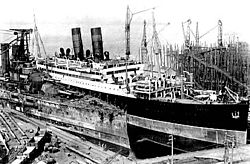RMS Andania (ship, 1913)
|
The Andania next to the HMS Ajax
|
||||||||||||||||||||
|
||||||||||||||||||||
|
||||||||||||||||||||
|
||||||||||||||||||||
|
||||||||||||||||||||
|
||||||||||||||||||||
The RMS Andania (I) was put into operation in 1913 Transatlantic - passenger steamer of the British shipping company Cunard Line , the passenger and freight traffic from the UK to Canada and the USA was used. The ship was sunk by a German submarine on January 17, 1918 .
The ship
The 13,405 GRT steel steamship Andania was built by the Greenock Dockyard Company at Scotts Shipbuilding and Engineering Company in the Scottish city of Greenock . The 158.58 meter long and 19.50 meter wide ship was launched on March 22, 1913 and was completed on July 13, 1913. The Andania was powered by two eight-cylinder quadruple expansion steam engines whose nominal power was estimated at 1324 hp. They allowed a maximum speed of 15 knots (27.8 km / h). It was equipped with two chimneys, two masts and two propellers . Her structurally identical sister ships were the RMS Alaunia (13,405 GRT, 1913) and the RMS Aurania (13,936 GRT, 1917). All three ships were only intended for the carriage of second and third class passengers. The Andania had passenger capacities for 520 passengers second and 1540 passengers third class. Instead of the outdated dormitories, the Andania had cabins for four to six people.
On July 14, 1913, the Andania ran in Liverpool on her maiden voyage via Southampton to Québec and Montreal . On August 19, 1913, she drove for the first time from London via Southampton to Québec and Montreal and in January 1914 she ran out for the first of three trips on the route Liverpool - Queenstown - Portland - Boston . From April 1914, the Andania again served the route London – Southampton – Québec – Montreal.
In August 1914, as a result of the outbreak of the First World War, it was converted into a troop transport that from then on carried Canadian soldiers. In 1915 it was also used on the Thames to accommodate German prisoners of war . During the Battle of Gallipoli , the Andania transported the Irish infantry regiments Royal Inniskilling Fusiliers and Royal Dublin Fusiliers from Cape Helles to Suvla . From March 18, 1916, the ship was used again in passenger traffic between London and New York and from January 31, 1917, the Andania again connected Liverpool with New York.
Sinking
On January 26, 1918, the Andania ran with 40 passengers and about 200 crew members in Liverpool for another crossing to New York. One day later, on January 27, 1918, she was hit two nautical miles northeast of the island of Rathlin in the north channel amidships by a torpedo from the German submarine U 46 under the command of Lieutenant for the Sea Leo Hillebrand.
The ship immediately got heavy list to starboard and began to sink. Attempts to tow the sinking ship failed. Seven crew members were killed when the Andania sank . The wreck of the ship lies at the position 55 ° 20 ′ N , 6 ° 12 ′ W at a depth of 175 to 189 meters.
